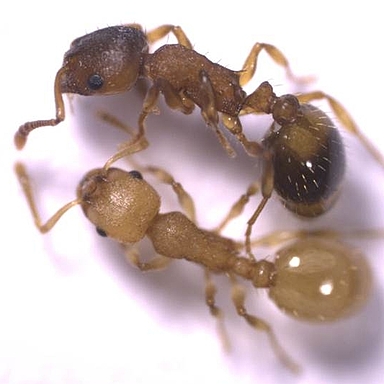Project 13.2

- PhD student: Giulia Blasi
- Supervisor: Susanne Foitzik
- Co-Supervisors: Joan Barau, Peter Baumann
- Further TAC-members: Hugo Darras
- Research Group
Many parasites manipulate their hosts at the molecular level to produce host phenotypes that promote transmission. How exactly parasites interfere with host gene regulation is poorly understood. This question is the focus of my dissertation on the ant Temnothorax nylanderi, which serves as an intermediate host for the tapeworm Anomotaenia brevis. Infection considerably alters the host, as infected workers are inactive but live significantly longer. I will analyze the epigenetic alterations caused by the infection.
Parasites include viruses, bacteria, and numerous eukaryotes, compromising fungi and cestodes (Ezenwa et al., 2012; van Houte, Ros & van Oers, 2013). Those with complex life cycles often modify the behavior, physiology, and morphology of their intermediate hosts to facilitate transmission to the final one (Lafferty and Shaw, 2013). These phenotypic changes have been termed the "extended phenotype of parasites" by Dawkins, as they can be encoded in the parasite's DNA and are under selection in the parasite (Dawkins, 1982).
Generally, parasite-induced changes are thought to favor the parasite to increase its survival and chances of completing the transmission cycle, but this is not always true. For instance, in the case of the carpenter ant Camponotus aethiops and the generalist insect pathogenic fungus Metarhizium brunneum infected ants change their behavior and tend to completely isolate themselves from other members of the colony to prevent the spread of infection (Bos et al., 2012). In contrast, the fungus Ophiocordyceps, which also infects ants of the genus Camponotus, can take control of the ant's nervous system, causing infected workers to remain on the foliage and die, thereby facilitating the spread of its spores (Evans and Samson, 1984; Andersen et al., 2009).
Something similar happens when the parasitic cestode Anomotaenia brevis infects the larva of the ant Temnothorax nylanderi, its intermediate host. When infected ants become adult workers, they exhibit morphological, behavioral and chemical alterations. Most interestingly, the lifespan of infected workers is greatly prolonged and comparable to that of the queen, who can live up to two decades in this species (Beros et al., 2015; 2021). These phenotypic changes are induced by the cestode, who is transcriptionally active during its cysticercoid phase, where it resides in the ants’ hemolymph (Stoldt et al., 2021). The cestode is actively releasing life-prolonging antioxidants and proteins with functions in the epigenetic regulation of gene expression (Hartke et al., ms). Indeed, gene expression in infected workers is altered in part also in response to the parasite load.
The transcriptional activity of genes is influenced by differential accessibility of DNA due to histone modifications, DNA methylation and miRNAs (Lawrence, et al. 2016; Poddar, Kesharwani, & Datta, 2017). It is possible that the cestode permanently alters the epigenetic regulation of host genes already during the larval phase. This could include immune pathways affecting melanization and sclerotization, as infected workers have a less pigmented and soft cuticle. The lower behavioral activity could also be the result of reduced expression of muscle genes (Feldmeyer et al. 2016), which leads to dysfunctional muscles.
Unraveling epigenetic changes is thus the next step in shedding light on the molecular interactions in this host-parasite model system. My Ph.D. project will thus focus on contrasting the epigenetic landscape of infected ants with uninfected ants. We will combine the study of histone modifications (CUT&TAG), DNA methylation (Bisulfite-Seq) and miRNAs in relation to the level of infection (number of cestodes) and changes in gene expression (RNA-Seq).